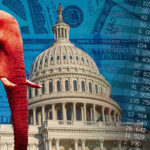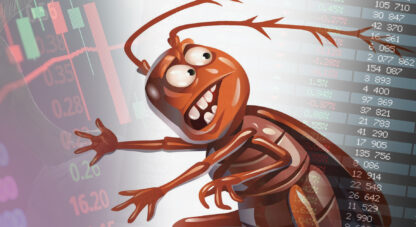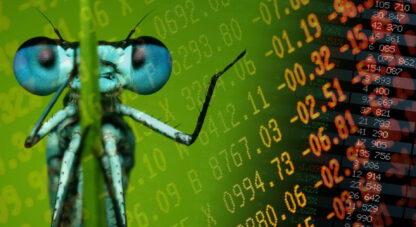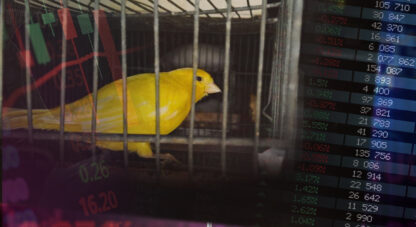For the Week:
The S&P500 gained 1.0% (up 25.3% y-t-d), and the Dow added 0.6% (up 20.3%). The Utilities were unchanged (up 19.0%). The Banks added 0.4% (up 27.9%), and the Broker/Dealers jumped 2.1% (up 21.7%). The Transports increased 0.7% (up 18.4%). The S&P 400 Midcaps rose 1.2% (up 20.9%), and the small cap Russell 2000 jumped 2.2% (up 20.5%). The Nasdaq100 advanced 1.6% (up 32.8%). The Semiconductors rose 1.5% (up 48.6%). The Biotechs surged 3.5% (up 18.5%). Though bullion fell $18, the HUI gold index gained 1.9% (up 33.8%).
Three-month Treasury bill rates ended the week at 1.54%. Two-year government yields dipped one basis point to 1.61% (down 88bps y-t-d). Five-year T-note yields were unchanged at 1.63% (down 89bps). Ten-year Treasury yields added one basis point to 1.78% (down 91bps). Long bond yields declined two bps to 2.21% (down 81bps). Benchmark Fannie Mae MBS yields slipped a basis point to 2.70% (down 80bps).
Greek 10-year yields rose five bps to 1.43% (down 297bps y-t-d). Ten-year Portuguese yields were about unchanged at 0.40% (down 132bps). Italian 10-year yields gained five bps to 1.23% (down 151bps). Spain’s 10-year yields added a basis point to 0.42% (down 100bps). German bund yields were unchanged at negative 0.36% (down 60bps). French yields slipped a basis point to negative 0.05% (down 76bps). The French to German 10-year bond spread narrowed one to 31 bps. U.K. 10-year gilt yields declined one basis point to 0.70% (down 58bps). U.K.’s FTSE equities index added 0.3% (up 9.2% y-t-d).
Japan’s Nikkei Equities Index gained 0.8% (up 16.4% y-t-d). Japanese 10-year “JGB” yields to negative 0.07% (down bps y-t-d). France’s CAC40 % (up 2%). The German DAX equities index increased 0.6% (up 25.4%). Spain’s IBEX 35 equities index rose 1.1% (up 9.5%). Italy’s FTSE MIB index was unchanged (up 26.9%). EM equities were mixed. Brazil’s Bovespa index declined 0.4% (up 18.9%), and Mexico’s Bolsa fell 0.4% (up 2.8%). South Korea’s Kospi index declined 0.7% (up 2.3%). India’s Sensex equities index advanced 1.1% (up 13.1%). China’s Shanghai Exchange dipped 0.5% (up 15.2%). Turkey’s Borsa Istanbul National 100 index added 0.3% (up 17.1%). Russia’s MICEX equities index declined 0.4% (up 23.9%).
Investment-grade bond funds saw inflows of $4.545 billion, and junk bond funds posted inflows of $348 million (from Lipper).
Freddie Mac 30-year fixed mortgage rates gained two bps to 3.68% (down 113bps y-o-y). Fifteen-year rates were unchanged at 3.15% (down 110bps). Five-year hybrid ARM rates rose four bps to 3.43% (down 69bps). Bankrate’s survey of jumbo mortgage borrowing costs had 30-year fixed rates up a basis point to 4.02% (down 64bps).
Federal Reserve Credit last week increased $14.5bn to $4.002 TN, with an 11-week gain of $275 billion. Over the past year, Fed Credit contracted $62bn, or 1.5%. Fed Credit inflated $1.191 Trillion, or 42%, over the past 367 weeks. Elsewhere, Fed holdings for foreign owners of Treasury, Agency Debt declined $0.6 billion last week to $3.415 TN. “Custody holdings” were up $13 billion, or 0.4% y-o-y.
M2 (narrow) “money” supply gained $30.1 billion last week to a record $15.326 TN. “Narrow money” rose $1.064 TN, or 7.5%, over the past year. For the week, Currency increased $0.7bn. Total Checkable Deposits dropped $45bn, while Savings Deposits jumped $73.4bn. Small Time Deposits declined $3.0bn. Retail Money Funds gained $4.8bn.
Total money market fund assets surged $50.4bn to $3.577 TN. Money Funds gained $657bn y-o-y, or 22.5%.
Total Commercial Paper jumped $17.2bn to $1.138 TN. CP was up $48bn, or 4.4% year-over-year.
Currency Watch:
The U.S. dollar index was unchanged at 98.27 (up 2.2% y-t-d). For the week on the upside, the British pound increased 0.7%, the Swedish krona 0.6%, the South African rand 0.3%, the New Zealand dollar 0.2%, and the Canadian dollar 0.2%. On the downside, the Brazilian real declined 1.0%, the Mexican peso 0.8%, the Japanese yen 0.8%, the Norwegian krone 0.7%, the Australian dollar 0.3%, the Swiss franc 0.3%, the Singapore dollar 0.3%, and the South Korean won 0.2%. The Chinese renminbi increased 0.08% versus the dollar this week (down 2.19% y-t-d).
Commodities Watch:
The Bloomberg Commodities Index dropped 2.1% this week (up 0.2% y-t-d). Spot Gold declined 1.2% to $1,444 (up 12.6%). Silver slipped 0.2% to $17.106 (up 10.1%). WTI crude sank $2.60 to $55.17 (up 22%). Gasoline dropped 5.0% (up 20%), and Natural Gas sank 15.8% (down 22%). Copper was little changed (up 1%). Wheat rallied 4.4% (up 8%). Corn increased 0.7% (up 2%).
Market Instability Watch:
November 29 – Wall Street Journal (Akane Otani): “It has been quiet in markets lately—so quiet that one measure of traders’ expectations for stock volatility recently touched its lowest level in more than a year. The Cboe Volatility Index, or VIX, finished Wednesday at 11.75. That was just a hair above where it ended Tuesday, which was its lowest closing level since Aug. 9, 2018…”
November 29 – Bloomberg (Joanna Ossinger): “Exchange-traded products are taking up a bigger chunk of Cboe Volatility Index futures trading than they have in about seven years, and that could be depressing the gauge, according to Nomura… When VIX-linked ETPs roll to the next month, they sell front-month futures on the volatility gauge to buy second-month ones. And when that activity becomes a larger portion of overall futures trading, it could have a bigger influence on the level of the index itself. The current impact of ETP rebalancing on the front VIX future is about 20% of daily volume on the index’s contracts, ‘just smashing the VIX future,’ according to Nomura Cross-Asset Strategist Charlie McElligott.”
Trump Administration Watch:
November 27 – CNS (Terence P. Jeffrey): “The federal debt has increased by $1,303,466.578.471.45 since last Thanksgiving,.. That is the largest Thanksgiving-to-Thanksgiving increase in the debt in nine years. The last time the debt increased more from Thanksgiving to Thanksgiving was in 2010, when it increased by $1,785,995,360,978.10. It also equals approximately $10,137.48 per household in the United States.”
November 26 – Reuters (Andrea Shalal and Kevin Yao): “The United States and China are close to agreement on the first phase of a trade deal, U.S. President Donald Trump said on Tuesday… Trump said Washington was in the ‘final throes’ of work on a deal that would defuse a 16-month trade war with Beijing, but also underscored Washington’s support for protesters in Hong Kong, a potential huge sore point with China. China said it had summoned U.S. Ambassador Terry Branstad on Monday to protest the passage in the U.S. Congress of the Hong Kong Human Rights and Democracy Act, saying the bill amounted to interference in a Chinese internal matter.”
November 22 – Reuters (Nick Timiraos): “President Donald Trump said… his administration would take a ‘good look’ at a Hong Kong bill that passed the U.S. Congress nearly unanimously, as lawmakers awaited his decision on whether he would sign it into law or issue a veto. Asked if he was going to sign the legislation, Trump said: ‘It’s being sent over (to the White House). We’re going to take a very good look at it.’ If Trump were to issue a veto, it would take two-thirds majorities in both the House of Representatives and Senate to override it and allow the bill to become law.”
November 24 – Reuters (Heather Timmons and Andrea Shalal): “An ambitious ‘phase two’ trade deal between the United States and China is looking less likely as the two countries struggle to strike a preliminary ‘phase one’ agreement, according to U.S. and Beijing officials, lawmakers and trade experts.”
Federal Reserve Watch:
November 25 – CNBC (Jeff Cox): “Federal Reserve economists warn that printing money to pay for deficit spending has been a disaster for other nations that have tried it. In a paper that discusses the burgeoning U.S. fiscal debt, Fed experts note that high levels are not necessarily unsustainable so long as income is rising at a faster pace. They note that countries that have gotten into trouble and looked to central banks to bail them out haven’t fared well. ‘A solution some countries with high levels of unsustainable debt have tried is printing money. In this scenario, the government borrows money by issuing bonds and then orders the central bank to buy those bonds by creating (printing) money,’ wrote Scott A. Wolla and Kaitlyn Frerking. ‘History has taught us, however, that this type of policy leads to extremely high rates of inflation (hyperinflation) and often ends in economic ruin.’”
November 25 – Bloomberg (Alex Harris and Katherine Greifeld): “Market participants leaped at the opportunity to lock in end-of year funding at Monday’s Federal Reserve repurchase-agreement operation, the first to be conducted with a 2020 maturity. The central bank boosted the size of its next operation in the wake of the result. Even with concern about liquidity having eased since September’s upheaval, the Federal Reserve Bank of New York’s Monday operation to inject cash into the financial system for 42 days attracted $49 billion in bids — almost twice the $25 billion available. This was the first of three term operations to provide funding past Dec. 31, with the bank planning another 42-day action on Dec. 2 and a 28-day offering on Dec. 9.”
November 25 – New York Times (Jeanna Smialek): “Federal Reserve officials have increasingly acknowledged that the labor market might have more room to run, and Chair Jerome H. Powell made the point in perhaps the plainest way yet during a… speech. While the job market is strong, benefiting low-wage workers and pulling prime-age adults back into the labor pool, ‘there is still plenty of room for building on these gains,’ he told a room full of local business leaders… ‘The Fed can play a role in this effort by steadfastly pursuing our goals of maximum employment and price stability,’ Mr. Powell said.”
November 25 – Bloomberg (Christopher Condon): “Federal Reserve Chairman Jerome Powell struck an upbeat tone in gauging the ability of policy makers to extend the record U.S. economic expansion, while signaling interest rates would probably remain on hold. ‘At this point in the long expansion, I see the glass as much more than half full,’ Powell said… ‘With the right policies, we can fill it further, building on the gains so far and spreading the benefits more broadly to all Americans.”
November 25 – Wall Street Journal (Nick Timiraos): “Top Federal Reserve officials are in the final stages of a search to fill two top staff jobs overseeing its financial markets operations… Candidates who have been considered for the New York Fed posts include private-sector economists Daleep Singh and Charles Himmelberg, according to these people. Lorie Logan, the interim manager of the central bank’s asset portfolio, is also seen as a front-runner for one of the two positions, these people said. The person in one of the jobs will oversee the central bank’s $4 trillion securities portfolio and open market operations, implementing Fed officials’ interest rate decisions. The other will handle the markets group’s operations and technology.”
U.S. Bubble Watch:
November 26 – Bloomberg (Reade Pickert): “Buyers snapped up new U.S. homes over the past two months at the fastest pace in more than 12 years, adding to signs of sturdy housing demand amid lower prices and borrowing costs. Single-family house sales ran at a 733,000 annualized pace in October, topping all estimates in a Bloomberg survey, following an upwardly revised 738,000 in September… Those were the two strongest readings since July 2007. The median sales price decreased 3.5% from a year earlier to $316,700.”
November 26 – CNBC (Diana Olick): “After shrinking for much of this year, home price gains are now growing again. On a national level, prices rose 3.2% annually in September, up from a 3.1% gain in August, according to the S&P CoreLogic Case-Shiller U.S. National Home Price Index. The 10-City Composite annual increase was 1.5%, unchanged from the previous month. The 20-City Composite rose 2.1% annually, up from 2.0% in August. Of the 20 cities covered, Phoenix, Charlotte, North Carolina, and Tampa, Florida, saw the highest annual gains, with 6.0%, 4.6% and 4.5% annual gains, respectively. Ten of the 20 cities saw larger price increases in the year ended in September 2019 versus the year ended in August 2019.”
November 26 – Wall Street Journal (Heather Somerville): “Once Silicon Valley’s highest-flying darlings, companies from WeWork to Uber Technologies Inc. have collectively lost about $100 billion in value this year, prompting some startup executives to talk up profitability over growth as venture-capital investors grow more cautious about spending. In recent weeks, car-subscription company Fair and software company UiPath have downsized. Scooter-renting company Lime has rejiggered its operations to prove to investors it can turn a profit. ‘We’ve been in the middle of a rollicking party that’s gone on for five years and someone has snapped on the light switch,’ said Chris Douvos, whose firm, Ahoy Capital, invests in venture-capital firms and startups. ‘We are all adjusting our eyes and no one has any idea how the rest of the night is going to go. That’s how Silicon Valley feels right now.’”
November 26 – Reuters (Lucia Mutikani): “The U.S. goods trade deficit fell sharply in October as both exports and imports declined, pointing to a continued reduction in trade flows that has been blamed on the Trump administration’ ‘America First’ policy. The… goods trade gap dropped 5.7% percent to $66.5 billion last month.”
November 26 – Reuters (Pete Schroeder): “Profits across U.S. banks dipped by $4.5 billion to $57.4 billion in the third quarter of 2019, as ‘nonrecurring events’ at three large financial institutions drove down sector growth, the Federal Deposit Insurance Corporation reported… Absent those events, which the FDIC said were previously disclosed asset writedowns by Bank of America, Wells Fargo, and Mufg Union Bank, the banking sector would have continued its march to record profits by posting a slight increase to its all-time high of $62.6 billion record in the second quarter.”
China Watch:
November 23 – Reuters (Cate Cadell): “The United States is the world’s biggest source of instability and its politicians are going around the world baselessly smearing China, the Chinese government’s top diplomat said… in a stinging attack at a G20 meeting in Japan. Relations between the world’s two largest economies have nose-dived amid a bitter trade war… and arguments over human rights, Hong Kong and U.S. support for Chinese-claimed Taiwan… ‘The United States is broadly engaged in unilateralism and protectionism, and is damaging multilateralism and the multilateral trading system. It has already become the world’s biggest destabilizing factor,’ China’s Foreign Ministry cited Wang as saying.”
November 23 – Bloomberg: “Chinese state media stepped up criticism of the U.S. and accused it of meddling in China’s domestic affairs, as President Donald Trump deliberates signing into a law an amendment that would require annual reviews of Hong Kong’s special trading status with it. Attempts to use Hong Kong ‘to contain China’s development is a pipe dream,’ according the state-run People’s Daily, while Foreign Minister Wang Yi… called the U.S. the ‘biggest destabilizing element.’ American politicians risk pushing the city into a ‘more dangerous abyss’ as they use the ‘Hong Kong card’ to contain China’s growth, the official Xinhua News Agency said…”
November 26 – CNBC (Evelyn Cheng): “The leaders of the U.S.-China trade negotiations held another phone call on Tuesday morning, China’s Ministry of Commerce said… ‘Both sides discussed resolving core issues of common concern, reached consensus on how to resolve related problems (and) agreed to stay in contact over remaining issues for a phase one agreement,’ the Chinese-language statement said…”
November 24 – Reuters (Bhargav Acharya, Tony Munroe, Gabriel Crossley and Andrea Shalal): “China and the United States are ‘moving closer to agreeing’ on a ‘phase one’ trade deal, the Global Times, a tabloid run by the ruling Communist Party’s official People’s Daily, reported… But the report noted that Washington and Beijing had not agreed on specifics or size of rollbacks of tariffs on Chinese goods. Beijing’s insistence that Washington roll back the Trump administration’s tariffs here has been a major sticking point.”
November 24 – Bloomberg: “China said it will raise penalties on violations of intellectual property rights in an attempt to address one of the sticking points in trade talks with the U.S. The country will also look into lowering the thresholds for criminal punishments for those who steal IP, according to guidelines issued by the government…. It didn’t elaborate on what such moves might entail. The U.S. wants China to commit to cracking down on IP theft and stop forcing U.S. companies to hand over their commercial secrets as a condition of doing business there.”
November 26 – Bloomberg: “The earliest-available indicators of China’s economic performance point to a continued slowdown in November. Economic growth was already the slowest in almost three decades in the third quarter, and Bloomberg Economics’ gauge aggregating the earliest data from financial markets and businesses shows that continuing, with a worsening picture for trade, sales manager sentiment, and factory prices. While tensions with the U.S. have eased since the two sides announced talks toward a so-called ‘phase one’ deal last month, a leading indicator for trade flows in Asia, South Korean exports, still contracted almost 10% in the first 20 days of November.”
November 28 – Reuters (Cheng Leng and Kevin Yao): “China has room to ease monetary policy further, but authorities should not be careless in how they use such stimulus options, a central bank official said…, reinforcing its cautious stance. ‘Our monetary policy has space…but such policy space cannot be squandered at will,’ Zhang Xuechun, the deputy director of the research bureau at the People’s Bank of China (PBOC), said…”
November 26 – Reuters (Stella Qiu and Se Young Lee): “Profits at China’s industrial firms shrank at their fastest pace in eight months in October, tracking sustained drops in producer prices and exports and underscoring slowing momentum in the world’s second-largest economy. Industrial profits fell 9.9% in October year-on-year to 427.56 billion yuan ($60.74bn)…, marking the biggest drop since January-February period and compared with a 5.3% decline in September.”
November 28 – Bloomberg: “From rural bank runs to surging consumer indebtedness and an unprecedented bond restructuring, mounting signs of financial stress in China are putting the nation’s policy makers to the test. Xi Jinping’s government faces an increasingly difficult balancing act as it tries to support the world’s second-largest economy without encouraging moral hazard and reckless spending. While authorities have so far been reluctant to rescue troubled borrowers and ramp up stimulus, the costs of maintaining that stance are rising as defaults increase and China’s slowdown deepens… Among China’s most vexing challenges is the deteriorating health of smaller lenders and regional state-owned companies, whose financial linkages risk triggering a downward spiral without support from Beijing. A landmark debt recast proposed this week by Tewoo Group, a state-owned commodities trader, has raised concerns about more financial turbulence in its home city of Tianjin.”
November 26 – Financial Times (Don Weinland): “Troubled banks in China are struggling to raise funds as concerns over the health of the financial system grow and confidence in state-led bailouts falters. China’s banking system is facing its greatest challenge in nearly 20 years after years of runaway growth and mounting bad debt levels, which have topped 40% of loans at some small lenders. The government has had to intervene in the operations of three local banks this year, starting with the takeover of Baoshang Bank in May, marking the first instance of a direct state takeover of a lender in two decades. Partial bailouts at two more lenders, Bank of Jinzhou and Hengfeng Bank, were also carried out this year with the hopes of calming nerves in the interbank market and avoiding a liquidity crisis for troubled banks that are heavily reliant on borrowing from the market. Despite those efforts, many banks are facing deteriorating funding conditions. Troubled banks have been able to secure only 20-40% of the funds they have sought to raise in the interbank market for negotiable certificates of deposit, a vital source of funding for many smaller lenders, since the takeover of Baoshang Bank, according to research from UBS. ‘They clearly have some liquidity issues,’ said May Yan, UBS’s head of greater China financials equity research.”
November 25 – Bloomberg: “China’s banking sector is showing signs of strain, with more than 13% of 4,379 lenders now considered ‘high risk’ by the central bank. The high risk category contains 586 banks and financing firms, most of which are smaller rural institutions, the People’s Bank of China said in its 2019 China Financial Stability Report… A first review last year found about 10% were deemed high risk, though that calculation didn’t include many consumer finance firms.”
November 24 – Bloomberg (Ina Zhou and Hong Shen): “Being state-owned in China no longer means being supported by the state, if the case of a troubled commodities trader is anything to go by. Tewoo Group Corp. proposed… that investors either suffer losses as much as 64% or accept delayed repayment with sharply reduced coupons on $1.25 billion of dollar bonds.The debt restructuring plan is the first of its kind for a state-owned enterprise, and increases the prospect of a default, which would at the very least be one of the biggest by an SOE in the dollar bond market in two decades. The company’s woes also raises fresh alarm about the health of Tianjin, the northern port city in which it’s based. A de facto default by Tewoo would be considered a ‘landmark case,’ said Cindy Huang, an analyst at S&P Global Ratings.”
November 25 – Bloomberg (Rebecca Choong Wilkins and Tongjian Dong): “A major Chinese commodity trader looks poised to become the most high-profile state-owned enterprise to default in the dollar bond market in over two decades. In a fresh sign that Beijing is more willing to allow failures in the politically sensitive SOE sector, Tewoo Group has offered an unprecedented debt restructuring plan that entails deep losses for investors or a swap for new bonds with significantly lower returns.”
November 28 – Bloomberg (Rebecca Choong Wilkins and Jing Zhao): “A Chinese steelmaker failed to repay a 1 billion yuan ($142 million) bond even after bondholders gave the company more than a month to find the cash. …Xiwang Group Co. didn’t meet the Wednesday repayment deadline for the principal and interest on the bond originally due Oct. 24… Bondholders approved the delay earlier this month.”
November 28 – Bloomberg (Gregor Stuart Hunter): “The number of Chinese companies failing to make payments will continue to rise in the year ahead as economic growth sputters and the government attempts to rein in support to indebted companies, according to Moody’s… The credit ratings company expects 40-50 new defaults in 2020, up from 35 this year, according to Ivan Chung, head of greater China credit research and analysis at Moody’s. He expects the total value of defaults would be below 200 billion yuan ($28bn), representing less than 1% of the size of China’s bond market.”
November 25 – Reuters (Stella Qiu, Cheng Leng and Huizhong Wu): “China needs to resolve outstanding financial risks, and must counter risks from ‘abnormal’ market fluctuations that stem from external shocks, said the central bank…, as Beijing prioritizes financial stability amid increasing challenges. Financial markets are highly sensitive to global trade situations and rising uncertainties in global liquidity, said the People’s Bank of China (PBOC) in its annual financial stability report, adding that it will step up real-time supervision on stock, bond, foreign exchange markets to prevent cross-sector risk contamination. Bond defaults may continue, so authorities must prevent the risks of such defaults from triggering systemic risks, it said, while penalties on regulatory violations in the securities market would be increased.”
November 27 – Wall Street Journal (Francis Yoon): “A UBS Group AG trader is winning big in the booming market for junk bonds issued by Chinese companies. Hong Kong-based Kelvin Zhao has made the Swiss bank nearly $30 million this year… He has become one of the biggest traders in a corner of finance that has grown rapidly: dollar bonds from Chinese borrowers with low or no credit ratings. There is now nearly $229 billion of such high-yield bonds outstanding, according to Fitch Ratings, up from $8.7 billion at the end of 2014.”
November 25 – Financial Times (Hudson Lockett in Hong Kong and Sun Yu): “A high-profile initiative to fire up funding for Chinese infrastructure has fallen short of meeting regions’ needs and ended up diverting some cash into the real estate sector instead of the public projects it is intended to support, analysis by the Financial Times shows. Beijing ordered a big increase in the issuance of so-called special-purpose bonds in late 2018, touting them as a way to fund specific projects including irrigation, transport and toll roads. This boost has helped the market to swell to $1.3tn in five years…, pulling a sizeable chunk of local financing out of the shadows. But a particularly flexible slice of these bonds that can be paid off using projects’ revenues has flowed largely into real estate projects. In total, 90% of this slice has ended up in the sector — an injection worth more than $370bn.”
November 25 – Financial Times (Tom Hancock): “China’s central bank has warned over the dangers of a rapid build-up in the country’s household debt, urging greater oversight of mortgages and consumer loans to decrease risks to the country’s financial system. Household leverage hit 60% of China’s gross domestic product as of the end of 2018, with total debt now equal to total household income… ‘The debt risks of the household sector and some low-income households in some regions are relatively prominent and should be paid attention to,’ the PBOC said, calling for tougher policies to ‘guard against household sector debt’.”
November 27 – Reuters (Kevin Yao, Stella Qiu, Leng Cheng): “China has brought forward 1 trillion yuan ($142.07bn) of the 2020 local government special bonds quota to this year as it seeks to avert a sharper economic slowdown. The finance ministry said… local governments must ensure that special purpose bonds — used to finance infrastructure projects — should be issued and used as early as possible. ‘To ensure we can see results early next year … and the economy can be effectively boosted as soon as possible,’ the ministry said…”
Brexit Watch:
November 25 – Reuters (Guy Faulconbridge and William James): “Former prime minister Tony Blair said… that Britain was in a dangerous mess and that neither his own Labour Party nor Prime Minister Boris Johnson’s Conservatives deserved to win a Dec. 12 election. Britain is holding an election three years ahead of schedule because parliament was deadlocked over Brexit, unable to agree on how or even whether to leave the European Union. ‘We’re a mess,’ Blair said… ‘The buoyancy of the world economy has kept us going up to now, but should that falter, we will be in deep trouble.’”
Central Banking Watch:
November 26 – Bloomberg (Craig Stirling and John Ainger): “Global central banks are approaching the end of the year with a collective shudder at the risky behavior that their low interest-rate policies are encouraging. Policy makers from European Central Bank and the Federal Reserve are among those raising cautionary flags at potentially unsafe investing stoked by their efforts to flood economies with ultra-cheap money. Stock indexes from the U.S. to India are at records, and low sovereign bond yields have pushed funds into property seeking better returns. The warnings are couched in measured language that doesn’t signal panic, but the combined message is one of growing anxiety, laced with the discomfort that central bankers can’t easily tighten policy either. The danger is that such risk-taking recreates a backdrop similar to that preceding the global financial crisis a decade ago.”
EM Watch:
November 29 – Bloomberg (Vrishti Beniwal): “India’s economy grew at its weakest pace in more than six years last quarter, a blow to Prime Minister Narendra Modi as he steps up action to stem the fallout. Gross domestic product rose 4.5% in the September quarter from a year ago, down from 5% in the previous quarter… Core infrastructure industries’ output declined 5.8% in October, the biggest contraction since at least 2005…”
November 27 – Reuters (Dave Sherwood): “Chilean lawmakers agreed… to fast-track reforms to beef up security, warning that a resurgence in violence and vandalism was threatening to derail the country’s 30-year-old democracy. Five weeks of unrest over inequality and shabby social services have left at least 26 dead and more than 13,500 injured, prosecutors said. Riots have hobbled the capital’s public transport system, once the envy of Latin America, and caused billions in losses for private business.”
Europe Watch:
November 28 – Associated Press (Pan Pylas): “Unemployment across the 19-country eurozone has fallen to its lowest rate since July 2008… The… rate across the single currency bloc declined in October to 7.5% from 7.6% the previous month. Over the month, the number of people out of work fell by 31,000 to 12.33 million.”
Global Bubble Watch:
November 25 – Reuters (Emma Farge): “Greenhouse gases in the atmosphere hit a new record in 2018, exceeding the average yearly increase of the last decade and reinforcing increasingly damaging weather patterns, the World Meteorological Organization (WMO) said… ‘There is no sign of a slowdown, let alone a decline, in greenhouse gases’ concentration in the atmosphere – despite all the commitments under the Paris Agreement on Climate Change,’ said WMO Secretary-General Petteri Taalas.”
November 26 – New York Times (Somini Sengupta): “With world leaders gathering in Madrid next week for their annual bargaining session over how to avert a climate catastrophe, the latest assessment issued by the United Nations said Tuesday that greenhouse gas emissions are still rising dangerously. ‘The summary findings are bleak,’ said the annual assessment, which is produced by the United Nations Environment Program and is formally known as the Emissions Gap Report. Countries have failed to halt the rise of greenhouse gas emissions despite repeated warnings from scientists, with China and the United States, the two biggest polluters, further increasing their emissions last year. The result, the authors added, is that ‘deeper and faster cuts are now required.’”
November 27 – Bloomberg (Michael Arnold and Anirban Nag): “Food prices are climbing fast in the world’s biggest emerging markets, posing a possible inflation threat after months of dormant pressures. Asia’s two largest developing economies face a price surge for staple products — pork in China and onions in India — that are central to consumers’ diets. In Turkey and Nigeria, supply problems are driving up costs, while United Nations data show global food prices rose at the fastest pace in October in more than two years. Asia’s two largest developing economies face a price surge for staple products — pork in China and onions in India — that are central to consumers’ diets.”
November 25 – Financial Times (Eric Platt and Arash Massoudi): “Companies unleashed a wave of global takeovers on Monday, agreeing more than $70bn in deals as multinationals targeted the booming US market to squeeze out competitors and find new sources of growth. Industry leaders such as US discount brokerage Charles Schwab, French luxury goods powerhouse LVMH, Swiss drugs company Novartis and Japanese conglomerate Mitsubishi all snapped up rivals to extend dominance over their sectors. The shopping spree suggests that a dealmaking boom across the corporate world remains intact, after a pause attributed to shrinking confidence among executives and fears of a slowdown in global growth.”
November 25 – Financial Times (Galia Velimukhametova): “Zombies continue to stalk the corporate landscape, and the horde is growing. The number of businesses in industrialised countries whose interest costs are in excess of their annual earnings — ‘zombie companies’, as they are sometimes known — has reached a level not seen since the global financial crisis. Bank of America Merrill Lynch estimates that there are 548 of these zombies in the OECD club of mostly rich nations, against a peak of 626 during the crash. These zombies have been kept alive by years of cheap borrowing costs, created by investors chasing whatever yield they can find in a long bull market for government bonds. This helps to explain why there are five times more zombies today than during the late 1990s, when interest rates were significantly higher worldwide.”
November 24 – Financial Times (Laura Noonan): “Europe’s four biggest investment banks cut $280bn of assets from their main US holding companies in the past three years as they withdrew from Wall Street and moved business away from the glare of regulators. The dramatic reshaping of the US operations of Deutsche Bank, Credit Suisse, UBS and Barclays shows how the banks are tackling their chronic profitability challenges in the country.”
November 25 – CNBC (Yun Li): “What a tough month it has been for bitcoin. The world’s most popular cryptocurrency sank to $6,558.14 on Monday, its lowest level since May… It lost $3,000 in value in just a month as China accelerated a crackdown on businesses involved in cryptocurrency operations, a reversal from President Xi Jinping’s previous signal to be more open to the blockchain technology. The coin last traded at $7,150.79.”
Japan Watch:
November 28 – Reuters (Daniel Leussink): “Japan’s industrial output slipped at the fastest pace since early last year in October, exposing widening cracks in the economy which faces a decline in domestic and foreign demand. Factory output fell 4.2% in October from the previous month…, below the median market forecast for a 2.1% fall and swinging from a 1.7% rise the previous month.”
Fixed-Income Bubble Watch:
November 24 – Wall Street Journal (Andrew Ackerman): “Some of the biggest names in finance are warning that the government’s plan to return Fannie Mae and Freddie Mac to private ownership risks disrupting a market critical to the U.S. housing system. The investors, including BlackRock Inc., Fidelity Investments and Pacific Investment Management Co., have told the Trump administration that any move to privatize Fannie and Freddie should include an explicit guarantee of the $5 trillion in mortgage-backed securities they issue, which only Congress can provide, according to people familiar with the matter. The Trump administration, by contrast, says it is willing to move forward without such a guarantee, arguing that it is past time for the government to reduce its role in housing.”
November 25 – Financial Times (Robert Armstrong): “The market for securities backed by the riskiest US car loans is booming, as yield-crazed investors shrug off nagging concerns over the health of the American consumer. Deals have been ‘going gangbusters’ in subprime auto asset-backed securities (ABS), said Jennifer Thomas, an analyst at Loomis Sayles… At $29bn so far this year, issuance of subprime auto ABS is on track to surpass 2018’s record haul of $32bn, according to data from Finsight… The lower-rated slices of recent deals are ‘five or six times oversubscribed’, said Ms Thomas. ‘The market is trading very well.’”
November 25 – Bloomberg (Kelsey Butler and Allison McNeely): “Private equity firms are increasingly turning to an obscure type of loan, once almost exclusively used to finance smaller deals, to fund larger and larger buyouts. Yet a growing number of analysts and investors warn the debt may be riskier than it appears. Demand for unitranches, which blend first-priority and subordinated loans into a single facility from just a handful of lenders, is surging as borrowers bypass conventional sources of financing in pursuit of greater speed and simplicity. Previously used solely to fund middle-market transactions, volume reached a record $10.7 billion last quarter as non-traditional lenders deploy more cash for deals that in the past may have gone to the institutional loan market. The frenzied growth is another example of how red-hot demand for private credit is reshaping the global lending landscape.”
Leveraged Speculation Watch:
November 27 – Bloomberg (Justin Carrigan and Steven Arons): “Deutsche Bank AG has found a willing partner in Goldman Sachs… as the German lender tries to quickly offload billions of euros worth of unwanted assets. The U.S. bank bought securities with a notional value of about 40 billion pounds ($51bn) from the German firm… It’s at least the second time Goldman Sachs has taken advantage of the sweeping deleveraging effort underway since Deutsche Bank Chief Executive Officer Christian Sewing unveiled a new turnaround plan in early July. In September, the U.S. investment bank purchased the Asian portion of a portfolio of equity derivatives that the German lender had put up for sale… And BNP Paribas previously agreed to take over the hedge fund business.”
Geopolitical Watch:
November 27 – CNBC (Grace Shao, Christine Wang and Evelyn Cheng): “China’s Ministry of Foreign Affairs said… the U.S. has ‘sinister intentions’ and its ‘plot’ is ‘doomed to fail,’ after President Donald Trump signed two bills supporting Hong Kong protesters into law. State media also published a statement from the Hong Kong liaison office, emphasizing its commitment to defending its ‘one country, two systems’ policy. ‘We are officially telling the U.S. and the handful of opposition politicians in Hong Kong who follow America’s lead to not underestimate our determination to protect Hong Kong’s prosperity and stability, don’t underestimate our belief to protect the ‘one country, two systems policy’ and don’t underestimate our capabilities and strategies in protecting our country’s sovereignty, safety, growth and rights,’ the office said…”
November 27 – Free Beacon (Adam Kredo): “Iran, China, and Russia will hold in the coming weeks their first-ever joint war drills, which leaders say are meant to send a ‘message to the world’ about increased military cooperation between the rogue countries. The commander of Iran’s navy, Rear Admiral Hossein Khanzadi, said… the Islamic Republic will team up with Moscow and Beijing within the next month to hold the mass war drills. ‘When we talk about joint wargames, we are talking about two or more countries with a high level of relations in various political, economic and social fields, which culminate in cooperation in the military sector, with wargames usually being the highest level of such cooperation,’ Khanzadi was quoted as saying…”
November 23 – CNBC (Frederick Kempe): “Iran faces a time of reckoning, and the stakes couldn’t be higher: potential war with the United States, the reversal of its gains across the Middle East and the future of its revolutionary state… This defining moment for Tehran – perhaps the most critical since the Iranian Revolution of 1979 — has been prompted by the Trump administration’s ‘maximum pressure’ campaign of sanctions, Iran’s dangerously declining economy, and the cumulative effect of Tehran’s domestic malfeasance and regional overstretch. Growing protests in Iran, Iraq and Lebanon have charged the atmosphere with urgency.”
November 25 – Reuters: “Four months before a swarm of drones and missiles crippled the world’s biggest oil processing facility in Saudi Arabia, Iranian security officials gathered at a heavily fortified compound in Tehran. The group included the top echelons of the Islamic Revolutionary Guard Corps, an elite branch of the Iranian military whose portfolio includes missile development and covert operations. The main topic that day in May: How to punish the United States for pulling out of a landmark nuclear treaty and re-imposing economic sanctions on Iran… With Major General Hossein Salami, leader of the Revolutionary Guards, looking on, a senior commander took the floor. ‘It is time to take out our swords and teach them a lesson,’ the commander said…”
November 24 – Bloomberg (Julia Fioretti, Iain Marlow, and Fion Li): “Hong Kong residents handed an overwhelming victory to pro-democracy candidates in a vote for local district councils on Sunday, a stunning repudiation of the city’s Beijing-backed government after months of increasingly violent protests seeking meaningful elections. Pro-democracy candidates won 85% seats of 452 seats up for election… In the last election in 2015, they had won about a quarter of all elected seats.”
November 25 – Reuters (Sharon Tam and Clare Jim): “Hong Kong leader Carrie Lam renewed her appeals for peace in the Chinese-ruled city on Tuesday but failed to offer any concessions to anti-government protesters despite a resounding victory for pro-democracy parties in local elections. Appearing tired and drawn, Lam spoke a day after results showed democratic candidates secured almost 90% of 452 district council seats in Sunday’s elections, which were widely seen as a barometer of the opposition to the Beijing-backed politician following months of unrest.”
November 25 – Reuters (Keith Zhai, James Pomfret and David Kirton): “Tightening control over efforts to manage the upheaval in Hong Kong, the Chinese leadership has set up a crisis command center on the mainland side of the border and is considering replacing its official liaison to the restive semi-autonomous city, people familiar with the matter said. As violent protests roil Hong Kong, top Chinese leaders in recent months have been managing their response from a villa on the outskirts of Shenzhen, bypassing the formal bureaucracy through which Beijing has supervised the financial hub for two decades.”
November 24 – Reuters (Yimou Lee and Ben Blanchard): “Taiwan President Tsai Ing-wen’s ruling party denounced China as an ‘enemy of democracy’ on Monday following fresh claims of Chinese interference in the island’s politics ahead of presidential and legislative elections on Jan. 11.”
November 23 – Reuters (Ben Blanchard): “Election campaigning in Taiwan was hit at the weekend by new allegations that Beijing had tried to meddle in the island’s politics. A Chinese defector, named as Wang ‘William’ Liqiang by Australian media, gave a sworn statement to the Australian Security Intelligence Organization, or ASIO, about Beijing’s efforts to influence politics in Taiwan, Hong Kong and Australia. In particular, Wang said he helped guide positive media attention toward certain Taiwanese politicians, including President Tsai Ing-wen’s main opponent, Han Kuo-yu of the Kuomintang party.”















